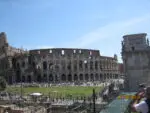The 300 Spartans who heroically defended the passage of Thermopylae against an enormous Persian army are probably among the first thing we think of when we hear the words Ancient Greece and Persian Wars. But were there really only 300 Spartans at the Battle of Thermopylae? Or how many Greek soldiers were really fighting in the Battle of Thermopylae?
The Greek army at the Battle of Thermopylae in August of 480 BC was approximately 7,000 men strong and consisted of 4,000 Peloponnesian Hoplites (including 300 Spartiates), 700 Hoplites from the city of Thespiae, 400 Hoplites from Thebes, 1,000 Phocian warriors and an army of Opuntian Locrians of unknown size. There was also an unknown number of Helots who were forced to accompany their Spartiate masters.
The Persian army that the Greeks had to face was much larger (although definitely not as large as the Ancient Greek historian Herodotus claims).
Let`s take a closer.
How many Greek soldiers fought at the Battle of Thermopylae?
The Thermopylae had been chosen carefully by the Hellenic League.
Not only was the passage of Thermopylae the second of three natural lines of defense against an invasion from the North (the first line of defense, the Vale of Tempe, proved to be ill-suited since it could easily be bypassed), but the narrow passage (at it`s narrowest point the passage of Thermopylae was only 65 – 98 ft (20 – 30 meters) wide) compensated the grossly inferior Greek numbers compared to the Persian army.
However, even though the Greeks were grossly outnumbered the claim that only 300 Spartans defended the passage of Thermopylae is wrong!
Yes, the 300 Spartiates were probably the most capable Greek soldiers at the Battle of Thermopylae (one of the reasons why they remained behind). But they weren`t the only ones.
There was a total of roughly 7,000 Greeks (6,000 Hoplites and 1,000 lighter armored infantrymen) at the Battle of Thermopylae as well as an unknown number of Helots who had to accompany their Spartiate masters to carry their equipment.
The 7,000 Greeks were also not all from one city but came from different cities of the Hellenic League, the alliance of a minority of Greek city-states dedicated to fighting against the Persian invasion.
It was actually quite common in ancient Greece that different allied city-states sent contingents of their own troops that were then combined with the contingents of allied city-states into one large army. Because of that practice, Greek armies could get pretty big, more on the size of Greek (and Spartan) armies in my article here.
So the army at the Battle of Thermopylae consisted of contingents from different member states of the Hellenic League that stood under the command of supreme commander Leonidas.
The different Peloponnesian city-states contributed a total of 4,000 Hoplites (including the 300 elite Spartiates from the city of Sparta), the city-state of Thebes contributed 400 Hoplites (there is the theory that these men might not have volunteered but were basically taken as hostages to ensure the well-behavior of their hometown), 700 Hoplites came from the city of Thespiae, and there were also 1,000 Phocian warriors and an army of Opuntian Locrians of unknown size.
7,000 men, 6,000 of them Hoplites, was certainly a formidable fighting force, especially when we consider that the narrow passage of Thermopylae didn`t allow the Persians to fully profit from their numerical advantage (the Persians had about 100,000 men).
But despite the geographical advantage, it was perfectly clear to the Greek generals (including Leonidas) that they would not be able to defeat the Persian army. However, defeating the Persian army was also not the Greek goal at the Battle of Thermopylae! The goal was to buy time for the Greek navy. Here you can find out what the Greek plan was for the Battle of Thermopylae and how they hoped to force the retreat of the Persian army without having to defeat the Persian army.
Ok, so now we have found out how many Greek soldiers were fighting at the Battle of Thermopylae. And we also know that Leonidas and his Spartans died at the Battle of Thermopylae (here you can find out more about why Leonidas and his men didn`t retreat).
But how many of the roughly 7,000 Greeks died in the battle aside from the Spartans and Leonidas?
How many Greeks died in the Battle of Thermopylae?
As I said, about 7,000 Greeks were fighting at the Battle of Thermopylae in 480 BC (plus an unknown and usually forgotten number of Helots who were forced to accompany their Spartiate masters to war).
But how many of them died?
Well, since the 300 Spartans fought till the end and died at Thermopylae we can also assume that the Helots who had to accompany them also died with them since it seems unlikely that the Spartiates would have allowed their servants to leave.
Herodotus, the main source for the Greco-Persian Wars, claims that 4,000 of the 7,000 Greeks who fought at the Battle of Thermopylae died. That number seems a little high. But it seems reasonable to assume that 2,000 to 4,000 Greeks, including the 300 Spartiates, died. Plus we also have to assume that all the Helots, an unknown number of them had been forced to accompany their Spartan masters, were also killed since it seems unlikely that they were allowed to leave.
Speaking of leaving the battlefield. Have you ever heard that Spartans were prohibited from retreating? If so I would like to recommend you my article here where I bust that myth.
And here you can find my article where I answer the question of why Leonidas and his Spartans (as well as the usually forgotten Thespians and Thebens) didn`t retreat despite Sparta not having a rule against retreat.
Speaking of Thebens, do you remember how I wrote that there is the theory that the Thebens were more or less hostages of the Spartans to ensure the well-behavior of their hometown Thebes? Well, although the 400 Hoplites from Thebes stayed behind together with Leonidas, the Spartiates, the Thespians, and an unknown number of Helots, they were the only ones who surrendered in time and survived.
So:
The Greek casualties at the Battle of Thermopylae in August of 480 BC were probably between 2,000 and 4,000 (of a total of 7,000) Greeks plus an unknown number (maybe 900) of Helots who had been forced to accompany their Spartiate masters.
That number is pretty high, the usual casualty rate of a Hoplite battle (even in case of a defeat) was lower.
However, despite the Battle of Thermopylae as one of the most famous battles of history (and one of the 4 major battles of the Greco-Persian Wars), one question always remains:
Why didn`t Leonidas and his Spartans retreat? Well, that is a story for another time. You can find the answer in my article here.
Take care of yourself because you deserve it. You really do.
Until next time
Yours truly
Luke Reitzer
Sources
Karl-Wilhelm Welweit: Sparta. Aufstieg und Niedergang einer antiken Großmacht (Stuttgart 2004).*
Disclaimer: This post contains affiliate links that are identifiable by the *. If you use these links to buy something we may earn a small commission without additional cost for you. Thanks.

